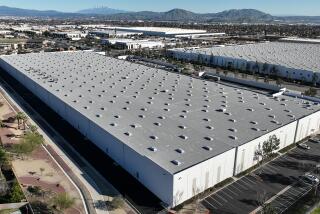Assembly OKs Bill Requiring Underground Rail Segment : County Objects to Measure Backed by Homeowners
The state Assembly on Monday approved a bill requiring that the proposed San Fernando Valley segment of Metro Rail be built underground along a 3.2-mile stretch through North Hollywood, Studio City, Van Nuys and Sherman Oaks.
The legislation, authored by state Sen. Alan Robbins (D-Tarzana), is strongly backed by homeowners, businesses and religious groups who fear an above-ground rail line would cause noise, congestion and safety problems and reduce property values.
Assembly members approved the bill despite objections that it would “Balkanize” transit planning efforts in Los Angeles County and that the state has no business dictating the design of a locally financed transit project.
The bill represents Robbins’ latest attempt to address complaints by homeowners and others concerned with possible adverse effects of mass transit projects in the Valley. In 1987, a Robbins bill to ban light-rail construction in North Hollywood and Van Nuys was defeated.
Central Segment
Under his latest bill, the Valley Metro Rail extension would have to be below ground level between the Hollywood Freeway and Hazeltine Avenue. In the central segment--between Laurel Canyon Boulevard and Woodman Avenue--it would have to be dug even deeper, at least 25 feet into the ground.
Robbins said he expects the Senate to take up the bill Wednesday or Thursday. However, the legislation is opposed by the Los Angeles County Transportation Commission and faces a possible veto by Gov. George Deukmejian.
Commission spokeswoman Erica Goebel said the commission does not think the state should involve itself in the engineering or routing of the Valley extension, which will be financed exclusively by a local sales tax increase approved by voters in 1980--unlike the Metro Rail from downtown to North Hollywood, which receives state and federal funds.
Goebel also noted that building a subway costs tens of millions of dollars more than an above-ground system. Construction costs on underground segments of Metro Rail downtown are running $190 million per mile, she said. By contrast, the cost of the light-rail link now under construction between Los Angeles and Long Beach is $32 million per mile.
The commission is drawing up an environmental impact report that is expected to analyze the effects of placing parts of the line in shallow trenches or deep tunnels. The report will study two main routes, one paralleling the Ventura Freeway and the other following Southern Pacific railroad’s Burbank branch line.
Shorten Line
Backers of the Robbins bill acknowledged that because of the higher costs, the practical effect of placing part of the Valley extension underground will be to shorten the overall line by about seven miles.
Assemblyman Richard Katz (D-Sylmar) said that instead of extending to Warner Center, the line would have to terminate near the Sepulveda Basin using existing funds. Supporters envision riders using express buses to get to points farther west.
During debate on the bill on the Assembly floor, Assemblyman William H. Lancaster (R-Covina) complained that the bill would benefit only Valley residents while its costs would have to be borne by taxpayers countywide.
But Assemblyman Tom Bane (D-Tarzana) said that the higher costs of a subway would be partly offset because it would not lower property values as an elevated line would, meaning that the county would not lose as much in property tax revenues.
More to Read
Sign up for Essential California
The most important California stories and recommendations in your inbox every morning.
You may occasionally receive promotional content from the Los Angeles Times.










